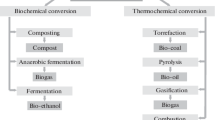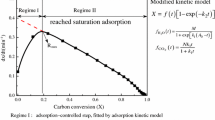Abstract
Experimental data for the heat of reaction during the hydrothermal carbonization (HTC) of biomass are scarce. Theoretical approaches can be found in literature, but the values are in a wide range. Up to now, there is no publication that presents a combination of theoretical estimation and experimental determination of the heat of reaction. The comparison is very important, for example to improve and validate the theoretical approaches. In this study, a new experimental setup at a heat flow DSC in temperature scanning mode is presented. It allows for the first time a comparison between measured and estimated values for the heat of reaction from the same HTC experiment: a sample mass of about 1.25 g, composed of biomass from a nature protection area and water, is carbonized while the heat of reaction is recorded. The usage of a removable glass container as inset allows to balance the process. The sample volume allows CHN analysis of the HTC-coal for theoretical estimations of the heat of reaction. The results show that the setup leads to reproducible results for the recorded heat flows and the CHN composition of the HTC-coal. Compared to the experimentally determined value for the heat of reaction of biomass in HTC process of \((-715.1\,\pm \,15.3)\, {{\text{J\,g}}^{-1}_{\text {daf}}}\), the estimation for the heat of reaction leads to an overrated value, even if the dissolved organic matter (dried on the coal) is considered in the energy balance.








Similar content being viewed by others
Abbreviations
- Cel:
-
Cellulose
- daf:
-
Dry and ash-free
- DOM:
-
Dissolved organic material
- DSC:
-
Differential scanning calorimetry
- HHV:
-
Higher heating value
- HTC:
-
Hydrothermal carbonization
References
Titirici MM, Thomas A, Antonietti M. Back in the black: hydrothermal carbonization of plant material as an efficient chemical process to treat the CO2 problem? New J Chem. 2007;31:787–9.
Funke A, Ziegler F. Hydrothermal carbonization of biomass: a summary and discussion of chemical mechanisms for process engineering. Biofuels Bioprod Biorefin. 2010;4:160–77.
Dinjus E, Kruse A, Tröger N. Hydrothermal carbonization - 1. influence of lignin in lignocelluloses. Chem Eng Technol. 2011;34:1–8.
Bergius F. Beiträge zur Theorie der Kohleentstehung. Die Naturwissenschaften. 1928;16:1–10.
Funke A, Ziegler F. Heat of reaction measurements for hydrothermal carbonization of biomass. Bioresour Technol. 2011;102:7595–8.
Yan W, Hastings JT, Acharjee TC, Coronella CJ, Vásquez VR. Mass and energy balances of wet torrefaction of lignocellulosic biomass. Energy Fuels. 2010;24:4738–42.
Coronella CJ, Lynam JG, Reza MT, Uddin MH. Hydrothermal carbonization of lignocellulosic biomass. In: Jin F, editor. Application of hydrothermal reactions to biomass conversion. Berlin Heidelberg: Springer Verlag; 2014. p. 275–311.
Berge ND, Ro KS, Mao J, Flora JRV, Chappell Ma, Bae S. Hydrothermal carbonization of municipal waste streams. Environ Sci Technol. 2011;45:5696–703.
Stemann J, Ziegler F. Assessment of the energetic efficiency of a continuously operating plant for hydrothermal carbonisation of biomass. In world renewable energy Congress. 2011;125–132.
Funke A, Ziegler F. Propagation of uncertainties and systematic errors in the measurements of long-lasting heat flows using differential scanning calorimetry. J Therm Anal Calorim. 2011;3:1317–24.
Channiwala SA, Parikh PP. A unified correlation for estimating HHV of solid, liquid and gaseous fuels. Fuel. 2002;81:1051–63.
Höhne GWH, Flemmiger WF, Flammersheim H. Differential scanning calorimetry. New York: Springer Verlag; 2003.
Terres E. Beitrag zur Kenntnis des Ablaufs der physikalischen und chemischen Vorgängen bei der thermischen Behandlung von Rohtorfen. Brennstoff-Chemie. 1952;33:353–61.
Funke A, Ziegler F. Hydrothermal carbonization of biomass: a literature survey focussing on its technical application and prospects. Eur Biomass Conf Exhib. 2009;17:1037–50.
Sevilla M, Fuertes AB. Chemical and structural properties of carbonaceous products obtained by hydrothermal carbonization of saccharides. Chem Eur J. 2009;15:4195–203.
Bergius F. Die Anwendung hoher Drücke bei chemischen Vogängen und eine Nachbildung des Enstehungsprozesses der Steinkohle. Halle a. d. Saale: Wilhelm Knapp; 1913;p. 41–58.
Fratzscher W, Picht HP. Stoffdaten und Kennwerte der Verfahrenstechnik. Leipzig: Deutscher Verlag für Grundstoffindustrie; 1979.
Schuhmacher JP, Huntjens FJ. Chemical structure and properies of coal XXVI—studies on artificial coalification. Fuel. 1960;39:223–34.
Sevilla M, Maciá-Agulló JA, Fuertes AB. Hydrothermal carbonization of biomass as a route for the sequestration of CO\(_2\): chemical and structural properties of the carbonized products. Biomass Bioenergy. 2011;35:3152–9.
Calucci L, Rasse DP, Forte C. Solid-state NMR characterization of chars obtained from hydrothermal carbonization of corncob and Miscanthus. Energy Fuels. 2012;27:303–9.
Liu Z, Quek A, Hoekman SK, Balasubramanian R. Production of solid biochar fuel from waste biomass by hydrothermal carbonization. Fuel. 2013;103:943–9.
Hoekman SK, Broch A, Robbins C, Zielinska B, Felix L. Hydrothermal carbonization (HTC) of selected woody and herbaceous biomass feedstocks. Biomass Convers Biorefin. 2012;3:113–26.
Xiao LP, Shi Z, Xu F, Sun RC. Hydrothermal carbonization of lignocellulosic biomass. Bioresour Technol. 2012;118:619–23.
Waldner MH, Vogel F. Renewable production of methane from woody biomass by catalytic hydrothermal gasification. Ind Eng Chem Res. 2005;44:4543–51.
Kruse A, Funke A, Titirici MM. Hydrothermal conversion of biomass to fuels and energetic materials. Curr Opin Chem Biol. 2013;3:1–7.
Meyer S, Glaser B, Quicker P. Technical, economical, and climate-related aspects of biochar production technologies: a literature review. Environ Sci Technol. 2011;45:9473–83.
Acknowledgements
This study was funded by the European Regional Development Fund (ERDF) project “HTC in Niedersachsen”.
Author information
Authors and Affiliations
Corresponding author
Rights and permissions
About this article
Cite this article
Rebling, T., von Frieling, P., Buchholz, J. et al. Hydrothermal carbonization: combination of heat of reaction measurements and theoretical estimations. J Therm Anal Calorim 119, 1941–1953 (2015). https://doi.org/10.1007/s10973-014-4361-7
Received:
Accepted:
Published:
Issue Date:
DOI: https://doi.org/10.1007/s10973-014-4361-7




